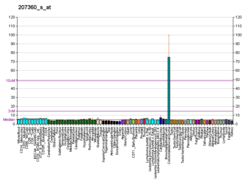Top Qs
Timeline
Chat
Perspective
Neurotensin receptor 1
Protein-coding gene in the species Homo sapiens From Wikipedia, the free encyclopedia
Remove ads
Neurotensin receptor type 1 is a protein that in humans is encoded by the NTSR1 gene.[5][6] The neurotensin receptor is primarily responsible for mediating the effects of the neuropeptide neurotensin.[7]
Remove ads
Structure
Summarize
Perspective
Neurotensin receptor type 1 (NTSR1) is a member of the class A G protein-coupled receptor (GPCR) superfamily, characterized by its canonical structure of seven transmembrane α-helices connected by extracellular and intracellular loops.[8] High-resolution crystal structures of NTSR1 have been determined in various functional states, including complexes with peptide agonists (such as the endogenous neurotensin fragment NTS8-13), non-peptide agonists, partial agonists, and antagonists, as well as in the ligand-free (apo) state.[9][10]
The neurotensin binding pocket is located on the extracellular side of the receptor, where neurotensin binds in an extended conformation nearly perpendicular to the membrane, with the C-terminus oriented toward the receptor core.[10] Key interactions involve charged residues in the binding pocket and the C-terminal arginine of neurotensin, while the receptor's activation is associated with conformational changes that propagate from the ligand-binding site through the transmembrane helices to the intracellular side.[9] The intracellular region of NTSR1 interacts with G proteins and β-arrestins, facilitating downstream signaling and receptor internalization; phosphorylation of specific intracellular sites is critical for stable β-arrestin binding.[11] Notably, the receptor also contains an amphipathic helix 8 following transmembrane helix 7, although its stability and presence may vary among different receptor states and constructs.[12]
Remove ads
Function
Neurotensin receptor 1, also called NTSR1, belongs to the large superfamily of G-protein coupled receptors and is considered a class-A GPCR. NTSR1 mediates multiple biological processes through modulation by neurotensin, such as low blood pressure, high blood sugar, low body temperature, antinociception, anti-neuronal damage [13] and regulation of intestinal motility and secretion.[6]
Neuromodulation
SBI-553 is an intracellular allosteric modulator that promotes β-arrestin recruitment but not canonical Gq signaling.[14] SBI-553 exerts β-arrestin-dependent effects on rodent behavior.[15]
The anti-nociceptive properties of NTSR1 has been shown to be modulated by SBI-810, an analog of SBI-553 via inhibition of NMDA receptor activity as well as extracellular-regulated signal kinase signaling in spinal cord neurons.[15] SBI-810 outperformed gabapentin and oliceridine in reducing opioid-induced reduced conditioned place preference, guarding, and facial grimacing in mice, indicating superior mitigation of opioid withdrawal.
Remove ads
Ligands
See also
References
Further reading
External links
Wikiwand - on
Seamless Wikipedia browsing. On steroids.
Remove ads





